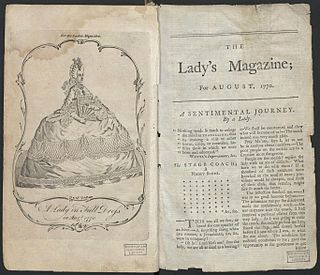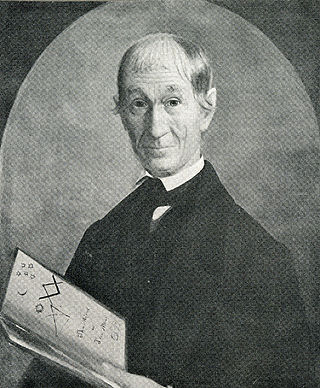
Martin Gardner was an American popular mathematics and popular science writer with interests also encompassing scientific skepticism, micromagic, philosophy, religion, and literature – especially the writings of Lewis Carroll, L. Frank Baum, and G. K. Chesterton. He was also a leading authority on Lewis Carroll. The Annotated Alice, which incorporated the text of Carroll's two Alice books, was his most successful work and sold over a million copies. He had a lifelong interest in magic and illusion and in 1999, MAGIC magazine named him as one of the "100 Most Influential Magicians of the Twentieth Century". He was a prolific and versatile author, publishing more than 100 books.

An almanac is a regularly published listing of a set of current information about one or multiple subjects. It includes information like weather forecasts, farmers' planting dates, tide tables, and other tabular data often arranged according to the calendar. Celestial figures and various statistics are found in almanacs, such as the rising and setting times of the Sun and Moon, dates of eclipses, hours of high and low tides, and religious festivals. The set of events noted in an almanac may be tailored for a specific group of readers, such as farmers, sailors, or astronomers.

The Lady's Magazine; or Entertaining Companion for the Fair Sex, Appropriated Solely to Their Use and Amusement, was an early British women's magazine published monthly from 1770 until 1847. Priced at sixpence per copy, it began publication in August 1770 by the London bookseller John Coote and the publisher John Wheble. It featured articles on fiction, poetry, fashion, music, and social gossip and was, according to the Victoria and Albert Museum, "the first woman's magazine to enjoy lasting success."

Olinthus Gilbert Gregory was an English mathematician, author, and editor.

Charles Hutton FRS FRSE LLD was an English mathematician and surveyor. He was professor of mathematics at the Royal Military Academy, Woolwich from 1773 to 1807. He is remembered for his calculation of the density of the earth from Nevil Maskelyne's measurements collected during the Schiehallion experiment.
William George Horner was a British mathematician. Proficient in classics and mathematics, he was a schoolmaster, headmaster and schoolkeeper who wrote extensively on functional equations, number theory and approximation theory, but also on optics. His contribution to approximation theory is honoured in the designation Horner's method, in particular respect of a paper in Philosophical Transactions of the Royal Society of London for 1819. The modern invention of the zoetrope, under the name Daedaleum in 1834, has been attributed to him.

The Old Farmer's Almanac is an almanac containing weather forecasts, planting charts, astronomical data, recipes, and articles. Topics include gardening, sports, astronomy, folklore, and predictions on trends in fashion, food, home, technology, and living for the coming year. Published every September, The Old Farmer's Almanac has been published continuously since 1792, making it the oldest continuously published periodical in North America. The publication was started by Robert B. Thomas and follows in the heritage of American almanacs such as Benjamin Franklin’s Poor Richard's Almanack.

Old Moore's Almanac is an almanac which has been published for nearly two and a half centuries. Its founder, Theophilus Moore, ran a classical academy at Milltown which was then a village near Dublin. A teacher of Irish, English, Greek and Latin, he became known as a clever mathematician and a wizard of astrology, gaining the nickname 'The Irish Merlin'. He published his Old Moore's Almanac for the first time in 1764, and received such support that the other Irish almanacs gradually dwindled away. Theophilus Moore is now buried in the Drumcondra Churchyard, in Dublin, but the tradition of Old Moore's Almanac continues unbroken to this day.

Mrs. Silence Dogood was the pen name used by Benjamin Franklin to get his work published in the New-England Courant, a newspaper founded and published by his brother James Franklin. This was after Benjamin Franklin was denied several times when he tried to publish letters under his own name in the Courant. The 14 Mrs. Silence Dogood letters were first printed in 1722.

In geometry, Napoleon's theorem states that if equilateral triangles are constructed on the sides of any triangle, either all outward or all inward, the lines connecting the centres of those equilateral triangles themselves form an equilateral triangle.
Gentleman's Diary or The Mathematical Repository was an almanac published at the end of the 18th century in England, including mathematical problems.
Nathan Daboll was an American teacher who wrote the mathematics textbook most commonly used in American schools in the first half of the 19th century. During the course of his career, he also operated a popular navigation school for merchant mariners, and published a variety of almanacs during the American Revolution period.

Dudley Leavitt was an American publisher. He was an early graduate of Phillips Exeter Academy in his native town of Exeter, New Hampshire, and later moved to Gilmanton where he first edited a newspaper and taught school. Within a few years, Leavitt relocated to Meredith, where in addition to teaching school and farming, he began publishing in 1797 Leavitt's Farmers Almanack, one of the nation's earliest farmers' almanacs. A polymath, Leavitt poured his knowledge of disparate fields including mathematics, language and astronomy into the wildly popular almanacs, which outlived their creator, being published until 1896. The inaugural issue of 1797 carried the title of The New England Calendar: Or, Almanack for the Year of Our Lord 1797. On the cover was the disclaimer that the new publication was "Calculated for the Meridian of Concord, Latitude 43° 14' N. Longitude 72° 45' W.: And with But Little Variation Will Answer for Any of the New England States."
John Tipper (1663–1713) was an English mathematician and almanac-maker, now known as the founder of The Ladies' Diary, in which some important mathematical results were first published.
In a publishing career spanning 80 years (1930–2010), popular mathematics and science writer Martin Gardner (1914–2010) authored or edited over 100 books and countless articles, columns and reviews.
A tradition of almanacs published for the purposes of North America began in New England in the 17th century. A New World's dwelling would seldom be found without the latest print of North American almanac and The Pilgrim's Progress.
The Lady's and Gentleman's Diary was a recreational mathematics magazine formed as a successor of The Ladies' Diary and Gentleman's Diary in 1841. It was published annually between 1841 and 1871 by the Company of Stationers; its editor from 1844 to 1865 was Wesley S. B. Woolhouse. It consisted mostly of problems posed by its readers, with their solutions given in later volumes, though it also contained word puzzles and poetry. The magazine was based in London. It ceased publication in 1871. This should not be confused with Ladies and Gentlemens Diary, or Royal Almanack which was printed by Thomas Carnan and edited by Reuben Burrow and was a short lived competitor to The Ladies' Diary.
Charlotte Caroline Richardson was a minor British poet and writer. Her life was shaped in part by the publication The Ladies' Diary.
Teri Perl is an American mathematics educator, author of mathematics resource books, and a co-founder of The Learning Company.











